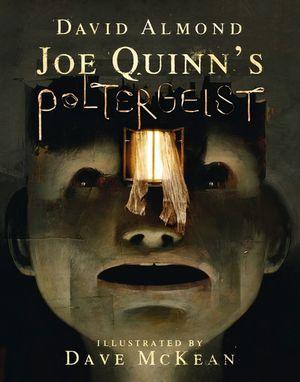David Almond (text) and Dave McKean (illustrator), Joe Quinn’s Poltergeist, Walker Books, April 2019, 80 pp., RRP $19.99 (hbk), ISBN 9781406363197
I unfairly judged this book by its cover. I was in no hurry to read it because it looked like ghoulish, pulpish, horror. But it’s by David Almond, so it has to be good right? Sure enough, two pages in, he had peaked my interest with his autobiographical introduction.
This a book that fuses formats and realms. David Almond uses fiction to explore his personal experiences of loss and hope, and his youthful interest in the supernatural. Dave McKean uses a combination of drawing, paint, collage, and photos to create a visual feast that feels more like a densely packed picture book than a graphic novel. It’s a visually lyrical read. McKean has managed to create a sense of motion with the pictures that pushes the reader through the feeling of cracking the cover on someone’s dream.
Joe Quinn’s Poltergeist is a coming of age story that explores and expresses hope ― hope that tries to push through the quietly nightmarish qualities of adolescence. Joe and Davie, two teenage boys, live on a council estate in northern England. Davie resents Joe for being insensitive after his sister died, but they are drawn together because Davie is the only person who believes that Joe has a poltergeist in his house. Both teens are dealing with feelings of loss and insecurity, and the adults in the story seem either too distracted or slippery to be of much use in the face of supernatural and emotional problems.
It’s not a book about bangs in the night. Not a lot happens really. But that feels like a metaphor for life on the estate. The story is infused with aimlessness, numbed grief, and diminishing respect for traditional figures of authority. There is a poltergeist that smashes things, but it’s a much less sinister force than the feelings that have been repressed, tensions that haven’t been dealt with, and the sense of foreboding that crosses the page each time a misguided or vaguely threatening adult appears.
I did wonder how appealing this book would be to an Australian YA reader. Whilst the vernacular and the illustrations give it a strong sense of place, I felt like my enjoyment of it relied quite heavily on stereotypes of 1970s and 1980s working-class Britain that I’ve gleaned from books and films. Others have recommended it for ages 9+, but in my opinion the setting, the dialect and the trope of the ominous priest might be too obscure for a tween or young teen who picks it up because they like the haunted house-ish cover. I liked its sepia-toned memoir quality, and the way it marries fantasy and reality to explore subtle tensions and pains. But it feels a bit like a slightly self-indulgent work of middle-aged nostalgia, so I don’t know if it will have wide appeal. It’s a coming of age story, but I suspect it might be more enjoyable from the adult side.
That said, there’s a thread of perseverance in the book that might resonate with teenagers living with hardships or who are navigating confusing relationships. Rather than overcoming or defeating darkness, Joe and Davie live alongside it and then life goes on. Joe Quinn’s Poltergeist might not suit a wide audience, and it will probably disappoint a few horror fans ― but I think this book has lots of understated and offbeat appeal. It’s nostalgic, it’s visually delicious, and it’s weirdly lovable.
Reviewed by Liz Patterson






